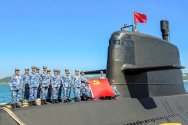Your source does not say Stirling engines are noisy. It says that Stirling combustion noise is small compared to the machinery noise - transmission noise. Hybrid cars are quiet - but that's not solely due to engine size. Motorcycles are loud with a much smaller engine. Regular cars are still louder despite equal engine. Hybrids are quiet because they can run the engine cycle quietly, and that's despite having a complicated transmission.Based on what I heard from my sources, they definitely do have noise and completely isolating those noise against low frequency sonar in deep water is not a given.
Yes, hybrid cars are quiet, but the engine in question would be a lot larger and deep sea water transmits sound really well.
I don't see why you would want to keep Stirling AIP when there are clearly better technology available now.
The purpose of Stirling is that diesel fuel has far higher energy density than battery, it isn't even close. even if you halve it to account for having to bring LOX, it is still far better than pure battery. It can remain submerged with no snorkeling much longer.
The purpose of pure lithium battery subs is if you have safe waters to snorkel in - waters free of enemy ASW planes - you can charge the batteries quickly on 1 snorkel. Otherwise, ASW planes can find the radar return of the snorkel or use an onboard gas sampler to find diesel fumes. It has to be ASW planes, because otherwise ships are limited by the radar horizon in looking for snorkels.
Japan has that luxury, since the only real opposing ASW planes are PLAN, and PLAN has to get air superiority first to deploy ASW planes. But PLAN itself does not enjoy ASW plane coverage out to the 2nd island chain, only in local waters. In this situation, PLAN conventional subs have to stay submerged as long as possible and only surface when 100% absolutely safe.
Note that at the end of your source, it says that lithium battery + AIP is a great combination and SK is working on that. I have no doubt that PLAN is working on that too and is upgrading old 039As by removing lead acid batteries and replacing them with LFP.
Now fuel cell is better than Stirling for noise alone but there's some weaknesses: you need a second fuel tank to run the fuel cell since its difficult to run fuel cells off diesel directly. German Type 212 keeps the fuel cell fuel in tanks outside the pressure hull. This makes for a larger submarine diameter for equal sized pressure hull and requires hull feedthroughs for the fuel lines, creating weak spots. Fuel cells also have high nominal efficiency, but only for H2. H2 is has low energy density, so you need either pressure (costly) or a chemical hydrogen generator from ammonia or methanol. This makes fuel cells somewhat inefficient at the end.
Last edited:


